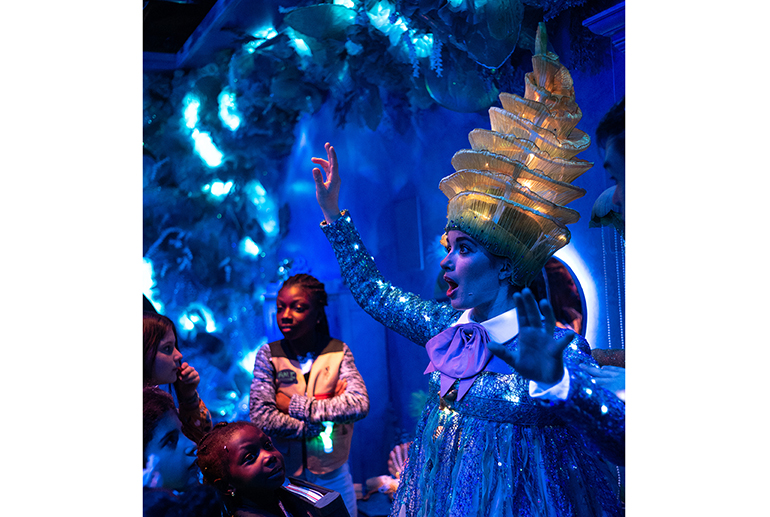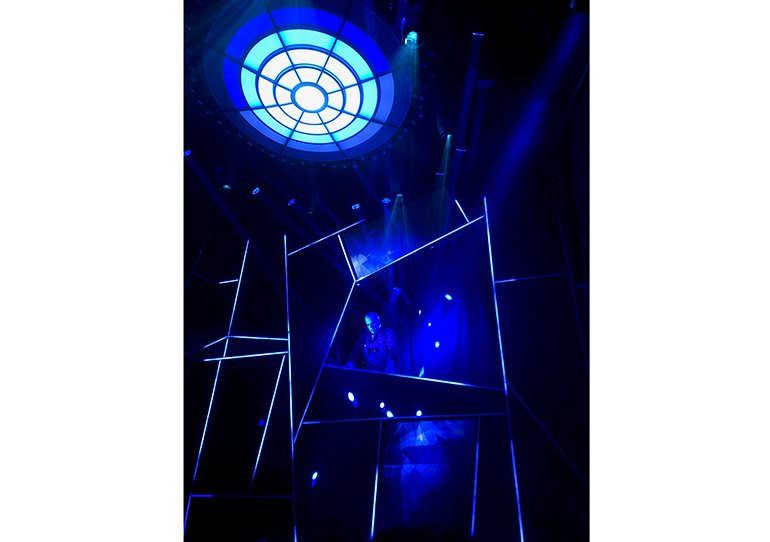New Yorkers and its visitors can now embark on a heroic journey to a mystical island—and we don’t mean Manhattan—and save its inhabitants from darkness via the custom-built flagship attraction, Pip’s Island, which is in previews and will officially open to the public on May 20. Nestled in the Pod Hotel on West 42nd Street, Pip’s Island combines innovative puppetry, digital animation, cutting-edge technology, and live actors to create an immersive theatrical adventure for young audiences and families.
Conceived and designed by its three founders, CEO Rami Ajami, Chief Creative Officer Rania Ajami, and creative director Walter Krudop, Pip’s Island made its world premiere in November 2016 in NYC for a limited engagement. Performers, puppets, and animated characters guide children ages four through 10 on an hour-long, empowering “hero’s journey” alongside Pip, Pebbles, and Finn, encountering challenges and games where they can earn signature achievement badges called “sparks,” which parallel many elements of the STEAM (science, technology, engineering, art, and mathematics) curriculum.
“Our mission is to provide a space where children are encouraged to find their inner spark and to positively impact the world around them,” says Krudop. “We create worlds where kids become heroes.” With immersive scenery and interactive set pieces, each thematic room invites children to take charge and share their light. “Pip’s Island is real ‘make-believe,’” Krudop adds. “They literally feel like they are entering a live video game and are pulled right into the story.”
Director of Production, David Valentino, realized the founders’ vision of a permanent home for Pip’s Island. “We wanted to assemble a world-class group of scenic fabricators, visual and installation artists, musicians, sound and lighting designers, puppeteers, and live actors to create a multi-sensorial world and original content with the majority of the set built in NYC,” explains Krudop. Valentino assembled just that: lighting designer Al Crawford; scenic fabricators Pink Sparrow, Monkey Boys, Paper Maché Monkey, John Creech Design and Production, and Infinite Scenic; video designer Rocco DiSanti; sound designer and show control designer Brett Jarvis; and more.
The Lighting Design
“It is an absolute story about light,” says world-renowned Alvin Ailey American Dance Theater lighting director, Al Crawford of Arc3Design. “So as a lighting designer, it is a particularly exciting project because the story itself and the whole experience is driven around light.”
On each expedition, children are equipped with a vest and a legendarium, a custom watch built with LED integration. The kids, called explorers, and any accompanying adults, dubbed assistant explorers, then embark on the maze-like journey, encountering electricity and light-inspired characters that help them earn their sparks to defeat the villain Joules Volter, who has stolen the light from the island. Different bespoke scenic environments present new challenges, and each one completed is one step closer to helping the island get its light back.

“It's about creating a fantastical place where light is the pulse of the island, it’s energy source, and in many ways, is connected directly to the explorer’s personal energy, what we call your Spark energy,” explains Crawford. Designed into the floor, walls, and throughout the visual environment is a light that pulses and moves to show strain and strength. As young explorers move through the experience, they realize that the energy source has been drained by the evil Joules Volter who has taken over the island’s Lighthouse. “They get a real sense of how the darkness affects the island. When they achieve these individual sparks by completing tasks together, they see the light coming back and that energy source growing. They see they are directly affecting the light and the opportunity to work together for good.”
For such an immersive experience, the lighting had to be as integrated and hidden as possible. “It required us to not go the off-the-shelf route in terms of lighting fixtures,” says the LD. “The selected lighting fixtures are much smaller than we would normally use in a traditional theater show so that we can tuck them into scenery and hide them in little coves. At last count, there are literally thousands of feet of City Theatrical LED tape and plenty of City Theatrical LED tape drivers throughout space.” The lighting rig also includes products by Elation Professional, American DJ, Mega Systems, and more, controlled via a pair of permanently installed ETC Eos remote processor units.

“One fixture in particular that I really love is the American DJ Saber Spot as it's one of the few small format, homogenized RGBW lighting fixtures of its kind,” says Crawford. “For its size, it produces a really beautiful 40° light. A lot of LED pars tend to be very tight, and I wanted something that could cover a lot of area and still be bright, and this ADJ fixture does that.”
The lighting team also really enjoyed the Elation Artiste Picasso and the Elation Dartz 360 moving lights. “These lighting fixtures became the driving force behind many of the effects in the final scene, The Lighthouse,” explains Crawford. “The Dartz 360 were used as virtual lightning bolts throughout the scene, taking advantage of their insane output and speed.”
This project made the experienced lighting designer think outside his normal range of fixture selections. “I tend to have a vocabulary of fixtures that I know and trust,” he reflects. “But this project really pushed me to explore a variety of options at other price points. Budget is a reality and we all had to work hard to maintain many of the concepts and balance costs.

In addition to a variety of black light effects, Crawford also incorporated old school, mechanical shadow effects where the explorers pull on ropes to control the movement of light and shadows that are backlit onto fabric. “It was exciting to explore some effects that are analogue in nature,” adds Crawford. 4Wall Lighting New York provided the rental lighting package as well as assisted with many of the custom purchases and integration.
Since the experience was built in a brand-new venue, building construction overlapped with the construction of the theatrical installation. “That can bring a lot of challenges when it comes to putting in a theatrical show while the building is still being built,” quips Crawford. “A great shout out to our production management team, Tinc Productions, particularly production manager Jameson Croasdale, who was the ringleader for the whole thing.”
The final scene is Crawford’s favorite. Joules Volter has taken over the Lighthouse, the main energy source for the island. As the good characters help the explorers to fight against the villain, Joules Volter suddenly shoots bolts of light from his hands to shock Pip. The lighting team created gloves with custom lamps, working with Boston-based Fuel Lighting Systems and City Theatrical on the wiring, integrating, and dimming. “We created literal beams, very, very bright beams coming out of his hands, and it's an unexpected moment because you expect that to come from the sky or the walls. But suddenly, there is this character literally emanating light from his hands, and that for me, from a design and a dynamic perspective, is my favorite,” he says.

Additionally, the lighthouse incorporates a significant scenic integration of over 130 universes of Enttec pixel RGBW LED tape, all driven by a PC-based system and Madrix Lighting Control software. “Madrix allowed us the freedom of mapping the room and manipulating light in a way that I’ve not been able to achieve on previous projects. We worked hand in hand with Tirso Lighting on the LED integration control infrastructure and Madrix setup. It was a complex map but they made it so we could navigate with ease,” Crawford explains.
“It was exciting to control something so immersive with ease. Our lighting programmer and longtime Arc3design lighting director, Zakaria Al-Alami, mastered the integration of both Madrix and ETC EOS Systems on the show seamlessly,” he adds.
To design, draft, and produce the lighting design for a project of this complexity is no small task. “Associate LDs Manuel Da Silva and Roya Abab and assistant LD Nicholas Palatella kept us all running at full speed throughout the process. Jarrod Jahoda, production electrician, mastered the impossible daily. It has been a really special project for our whole team for years,” says the designer.
“To work on a project that is so much in the hands of the young person and so positive of an experience, it is the kind of work that we love,” Crawford concludes. “It is theater that matters. Already just in previews, New York is going wild for Pip’s Island, and I know, it will do the same wherever it lands.”
Stay tuned for more on the immersive set design, video design, sound design, and show control for Pip's Island.
